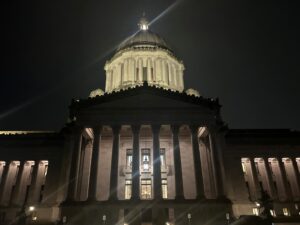
This place has been keeping the lights on these past couple of weeks!
(Photo Courtesy: Erica Hallock)
Trivia!
Which recently retired legislator built and lived in a geodesic dome in a parking lot for several weeks as a college student?
Bonus question #1: What is a geodesic dome?
Bonus question #2: Why did this former legislator live in this dome?
Highlights of the Week
Floor Cutoff and the “5:00 Bills”
Wednesday March 12 at 5:00 p.m. was the official “House of Origin” cutoff. This cutoff served as the deadline for bills to be passed out of their House of Origin to continue to be viable this year. As I’ve mentioned previously, bills deemed “Necessary to Implement the Budget” (or “NTIB”) are not subject to these cutoff deadlines.
Often the Senate and House will schedule bills that involve lengthy debate as the so-called “5:00 bill” because as long as they begin work on a bill before 5:00 p.m. on the House of Origin deadline, they can work on the bill for as long as it takes. As the cutoff deadline gets closer, speculation among lobbyists who have spent the past ten days camped out on the third floor of the Legislative Building intensifies as to what the 5:00 bills will be in both chambers.
The strategy around the scheduling of 5:00 bills is deployed because, particularly as the week moves on, time becomes a precious commodity and there may not be enough time to get through all of the bills on the Floor calendar. This was especially true in the House of Representatives which worked well into the early morning hours over the weekend on highly controversial issues, debating bills and what felt like unending lists of amendments. In contrast, the Senate did not work this past weekend and wrapped up by 5:00 p.m. every day.
The Senate opted for its “5:00 bill” to be the bipartisan special education bill sponsored by the Majority and Minority leaders, E2SSB 5263 (Pedersen/Braun). This bill does have an early learning connection as it contains a provision to increase the funding “multiplier” for the Early Support for Infants and Toddlers (ESIT) program to align it with the higher multiplier for pre-K children. This increased multiplier would result in additional funding for ESIT programs.
This bipartisan bill passed unanimously and after thanking their staff for their efforts, the Senate adjourned at a respectable 5:15 p.m.
Over in the House, their “5:00 bill” was SHB 1296 (Stonier), otherwise known as the Parental Rights bill. In contrast to the Senate’s 5:00 bill, this bill was the opposite of bi-partisan and after roughly 2.5 hours of party caucus meetings, the body dove into debate on scores of amendments around 7:30 p.m. and finally adjourned around 2:20 a.m. after passing the measure.
Early Learning and Child Care Cost Savings Bill Passes Senate
In one of the final bills debated in the Senate before the House of Origin cutoff, the Senate passed ESSB 5752 (C. Wilson) which modifies various aspects of the state’s early learning and child care system to achieve more than an estimated $800 million in cost savings. Some of the key provisions include delaying ECEAP entitlement, pushing out income eligibility expansion for Working Connections Child Care and increasing family co-payments for Working Connections Child Care. For a summary of the underlying bill, see the February 28 Notes from Olympia.
Prior to the bill’s final passage, the body adopted a striking amendment as well as an amendment to the striker. As a reminder, a “striker” is a type of amendment that replaces the entire bill with a new version, effectively striking everything after the bill title.
The striker and the amendment to the striker kept most of the underlying bill’s provisions but made the following changes to the underlying bill:
- Removes the repeal of the Early ECEAP program and instead makes the program subject to appropriation and enrollment dependent upon space availability.
- Clarifies that the household co-payment for the Working Connections Child Care program for families with incomes above 60% of the State Median Income is $310 a month.
- Makes the expanded definition of eligible child for ECEAP that is contained within the statute take effect July 1, 2025, instead of July 1, 2026.
- Removes a child who is a member of an assistance unit that is eligible for or is receiving basic food benefits from the definition of eligible child for ECEAP.
- Directs DCYF to adopt a rule that requires prospective payments to child care providers who accept Working Connections Child Care subsidies to occur when child care is expected to begin, and another rule that prohibits child care providers from claiming a prospective payment when a child has not attended at least one day within the authorization period in the previous month.
- Removes language providing that a household’s 12-month authorization begins on the date that child care is expected to begin.
- Directs DCYF to publish a cost of quality child care and market rate study and submit the study to the relevant committees of the Legislature by June 1st of every even-numbered year.
The bill passed the Senate on a 32-16-1 vote with three Republicans joining the Democrats to vote for passage. In brief remarks, Senator Chris Gildon noted he personally would vote in favor of the bill, but cited his caucus’ concern with the proposed co-payment increases as rationale for their opposition.
I encourage you to watch Senator Claire Wilson’s remarks on final passage of the bill (found at 26:50). She explains the challenge of our state’s budget situation led her to sponsor this bill and she reluctantly asked her fellow Senators for their support.
Early Learning Facilities Bills Both Still Moving
In a session where bills are dying left and right, it is unusual to have companion bills still alive at this stage in the process, but that is the case for the bills that seek to make improvements to the Early Learning Facilities Fund.
On March 10, the Senate unanimously approved SB 5297 (Trudeau/Torres) and that bill has been referred to the House Capital Budget Committee. It has not yet been scheduled for action in that committee. Its House companion, HB 1314 (Callan/Abbarno) was scheduled for Executive Session in the Senate Ways and Means Committee on March 13 (after our publication deadline).
You might be asking “did I miss the public hearing for HB 1314 in Senate Ways and Means?” Good question. You did not. Because the Senate Ways and Means Committee heard and passed the identical bill (SB 5297), the committee skipped the public hearing and scheduled HB 1314 straight to Executive Session.
To read more about the details of SB 5297, check out this one-pager on Start Early Washington’s policy resources page.
Policy Committee Action Resumes Policy Committee Action Resumes
The legislative calendar has a flow and, like clockwork, immediately following the House of Origin cutoff, the work transferred from the Legislative Building back to committee hearing rooms first thing on Thursday morning at 8:00 a.m. Thankfully for House members still recovering from their late night, their committee meetings were not scheduled to start until 10:30 a.m. Coffee, please!
The Senate Early Learning & K-12 Education Committee heard one early learning related bill at its March 13 morning committee meeting, E2SHB 1648 (Dent) related to child care provider qualifications. An amendment adopted on the House Floor, to E2SHB 1648 changed the deadline for when current child care providers must complete educational requirements, complete community-based pathway trainings, or demonstrate experience-based competency to August 1, 2030. The underlying bill included a deadline of August 1, 2032 and current law has an August 1, 2026 deadline.
What’s on Deck for Next Week
Ahoy – Seafood Day Awaits!
If you happen to be on the Capitol campus on March 20, be sure to check out seafood day. Pro tip: don’t get so excited about the free seafood that you cut in front of a really friendly State Senator who is just looking for a shrimp cocktail after a long day of budget negotiations.
Revenue Forecast Release
On March 18 at 2:00 p.m., all eyes in Olympia will be on the Washington State Economic and Revenue Forecast Council meeting where the State Economist will provide an updated revenue forecast. This forecast will inform budget writers about our state’s revenue outlook – are expected revenues higher than projected, or lower? How is the uncertainty around the federal government’s actions impacting this forecast?
Conventional wisdom is that the target for the Senate and House of Representatives to release their respective budget proposals will be early in the week of March 24. As of this writing it is unclear if one or both budgets will include a mix of proposed revenue/cuts or will be all-cuts to meet the proposed budget gap.
Following the release of the Senate and House budget proposals, legislative budget writers will work together – and with Governor Ferguson – to arrive at a final budget that will both balance and secure sufficient votes for passage. Whether this can be achieved before the scheduled adjournment date of April 27 is yet to be seen.
Continued Policy Committee Work – Next Cutoff is April 2
While budget writers focus on finalizing the budget details, policy committees will continue to work through policy bills in advance of the next cutoff on April 2. With fewer bills in play, the volume will be less than it was the first go-around. As of this writing, only one early learning bill is scheduled for a hearing next week. On March 19, the Senate Early Learning & K-12 Committee will hear SHB 1351 (Bernbaum) related to adjusting the age requirements for the Early Childhood Education and Assistance Program (ECEAP). I do expect more bills to get scheduled as the days progress.




